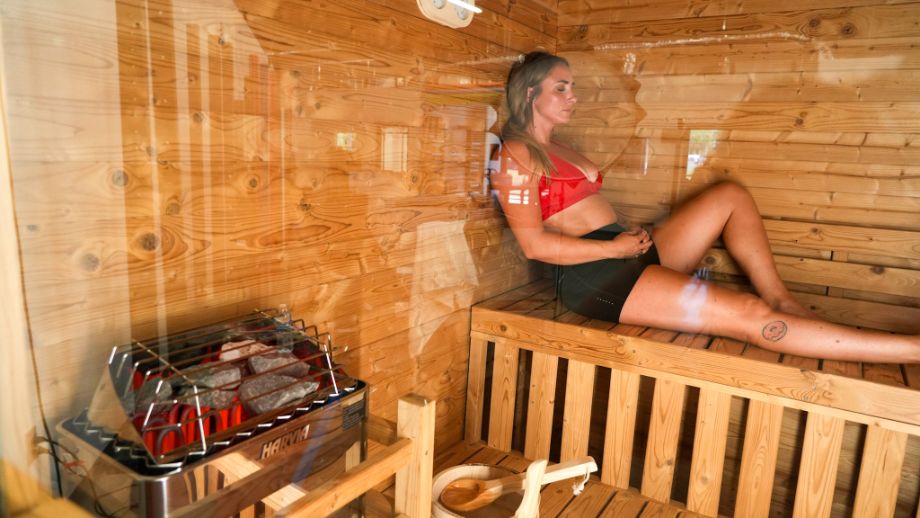We test and review fitness products based on an independent, multi-point methodology. If you use our links to purchase something, we may earn a commission. Read our disclosures.
Hot and cold therapies are all the rage right now. And, if you follow the health and wellness community online, you may notice your social media feeds are filled with folks talking about the ice bath benefits, influencers plunging into cold water, or building DIY backyard saunas.
But is all the buzz around heat therapy worth investing in one of the best home saunas or steam rooms?
There are benefits of elevating your body’s temperature and exposure to both dry and moist heat. But in the steam room vs sauna debate, what is the difference, and which one provides the most benefit? We’ll dive into an overview of both saunas and steam rooms and go over the potential benefits of each.
Medical disclaimer: This article is intended for educational and informational purposes only. It is not intended as a substitute for medical advice. For health advice, contact a licensed healthcare provider.
Sauna Vs Steam Room: What’s the Difference?
For the most part, saunas and steam rooms are remarkably similar. They are both enclosed areas or stand-alone structures that produce heat upwards of 100 degrees Fahrenheit. The biggest difference between these two popular heat therapies is that stream rooms produce hot, humid air via steam, and saunas produce a dry heat.
Here’s a quick breakdown of what that looks like:
- Steam rooms generally range from 100 to 120 degrees with 100% humidity
- Saunas range from 160 to 200 degrees with 10 to 20% humidity
What is a Steam Room?
Steam rooms are rare in private homes and are often associated with Turkish baths and public bathhouses—which still exist but not like they once did in ancient Roman and Greek cultures. Steam rooms also typically require plumbing to a steam generator for venting steam (aka humid air) directly into the steam room.
RELATED: Steam Room Benefits
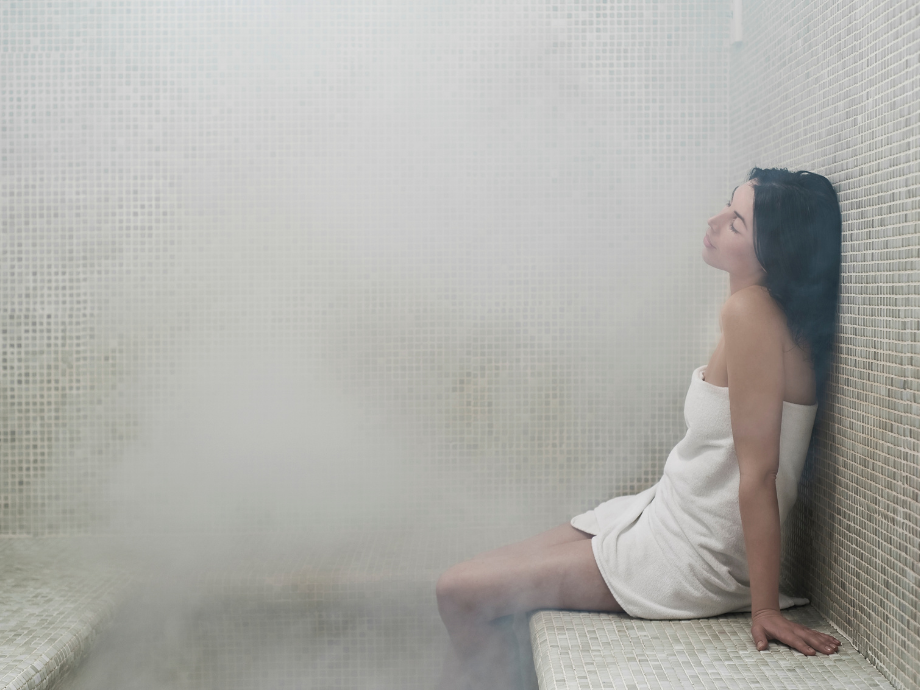
Another issue steam rooms pose for private homes is the fact an area in your home with 100 to 120 degree temperatures and 100% humidity is subject to mold issues.
What is a Sauna?
While there are different types of saunas—wood fired, electric, and the infrared sauna to name a few—for the purposes of this comparison we’re going to stick to traditional saunas. These are the types of saunas with long histories of use in Nordic countries like Finland.
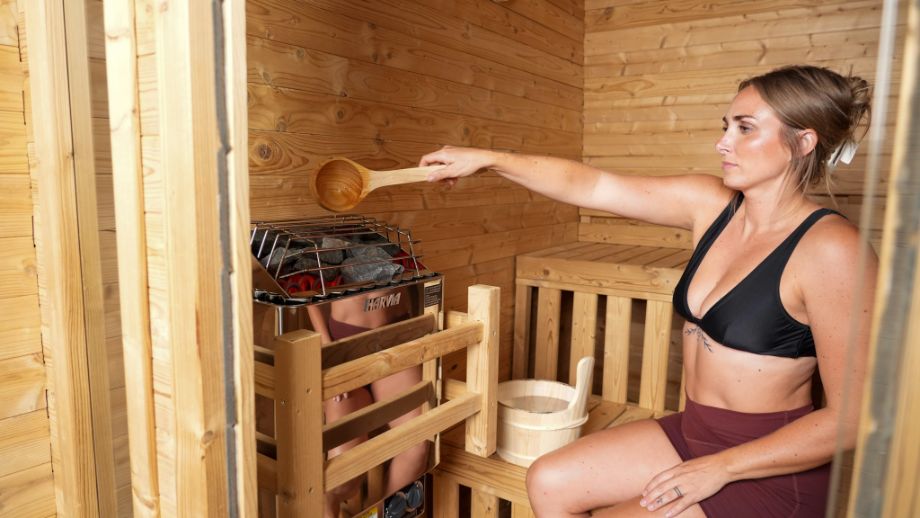
Traditional saunas are typically wooden, stand-alone structures with either a wood burning or electric healing source that provides dry heat. While dry saunas offer hotter temperatures (ranging from 160 to 200 degrees) and low humidity (about 20%), you can typically pour water over hot rocks placed on or above the heating element. This can temporarily increase the humidity to your personal preference.
Benefits of Sauna Sessions
In Nordic cultures, sauna use is known to have a multitude of wellness benefits including relief from sore muscles, better sleep, weight loss, detox from heavy metals, and relief from stiff joints.
There are even studies that show sauna rooms can help improve cardiovascular health and reduce the risk of heart disease. Let’s dive into the top benefits of dry heat therapy:
May Increase Blood Circulation
When you enter a sauna (or steam room, for that matter) with elevated temperatures, your core body temperature rises, and circulation to the skin increases. According to a Mayo Clinic1 review, this happens because your blood vessels expand for more efficient blood flow to your skin, which increases cardiac output while at the same time decreasing blood flow to internal organs.
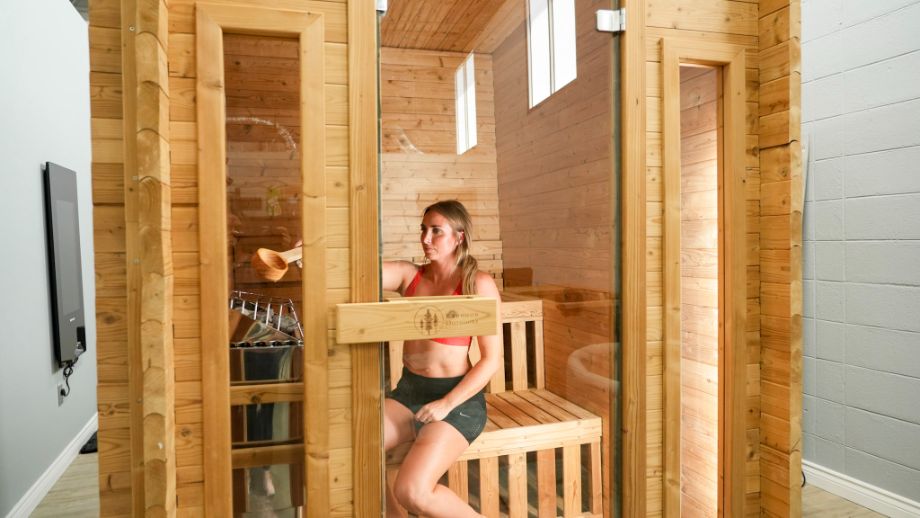
The same review notes that the increased blood flow to your skin will also increase how much you sweat, which leads to a reduction in your blood pressure and an uptick in your heart rate. Increased blood flow to your skin can also generally help with skin health2, seeing as it’s the largest organ of your body.
RELATED: Does Cardio Lower Blood Pressure?
May Help Improve Cardiovascular Health
Speaking of increased heart rate, a 2015 study published by JAMA Internal Medicine3 found that frequent sauna use and sauna bathing is associated with a reduced risk of sudden cardiac death, fatal coronary heart disease, and fatal cardiovascular disease.
If you’re wondering how regular sauna sessions can benefit heart health, it’s actually pretty simple: Your heart rate increases4 in a hot environment, similar to how it responds to moderate cardiovascular exercise. And your heart is like any other muscle you work at the gym; it needs some amount of stress to maintain its strength.
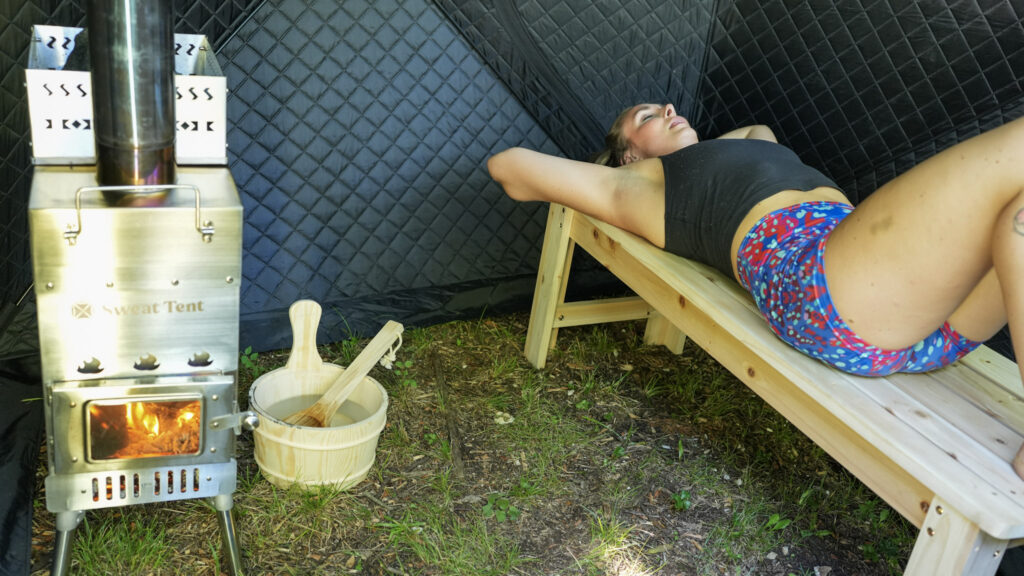
GGR expert panelist Michael Massi, doctor of physical therapy (DPT) and strength coach, notes that saunas and steam rooms provide many of the same benefits as exercise.
“These outcomes have been very well established as adaptations to physical activity. So, in my line of work as a strength coach and physical therapist, I know I can achieve the same result with movement and exercise prescription,” Michael says.
RELATED: Cardiovascular Exercises to Improve Your Fitness
May Help Lower Blood Pressure
As stated earlier, when sauna bathing your blood flow naturally increases to your skin, which leads to more sweating, which typically reduces your blood pressure and increases your heart rate.
RELATED: Tips to Understanding Your Heart Rate
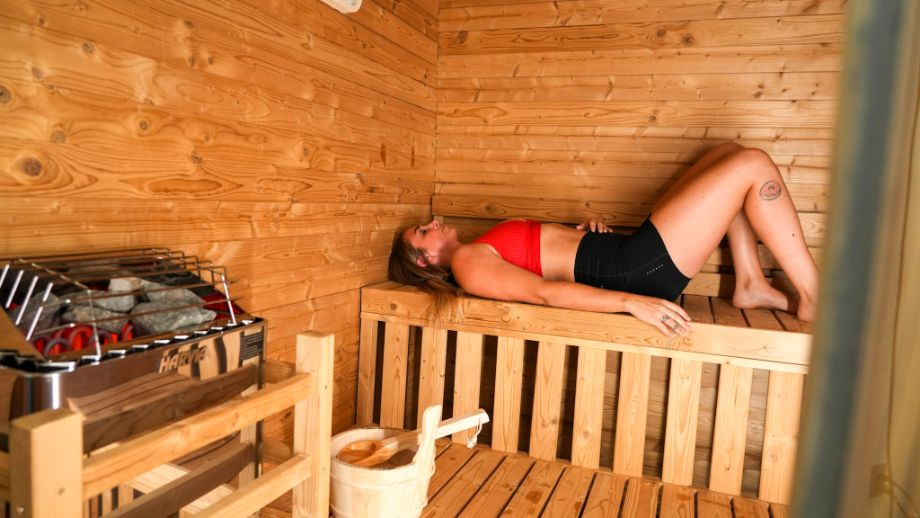
While that response may sound temporary, a small study published by Complementary Therapies in Medicine5 tested the blood pressure of 19 participants before, during, and after sauna bathing. The study found that people’s heart rates and blood pressure increased while in the sauna but were lower than their original baseline when tested 30 minutes after the sauna.
It’s worth noting that this study was done on healthy subjects, not folks with high blood pressure, heart disease, or chronic illness.
May Improve Muscle Recovery
While there are many benefits of sauna after workout (including just to relax for your mental health), one of the main benefits is reducing muscle soreness and aiding recovery.
A 2015 study published by Scandinavian Journal of Clinical and Laboratory Investigation6 found that a single use of a traditional Finnish sauna after aerobic exercise reduced free radicals (aka oxidative stress). When you have too much oxidative stress, it can damage the body’s cells and proteins and reduce the rate of recovery from strenuous exercise.
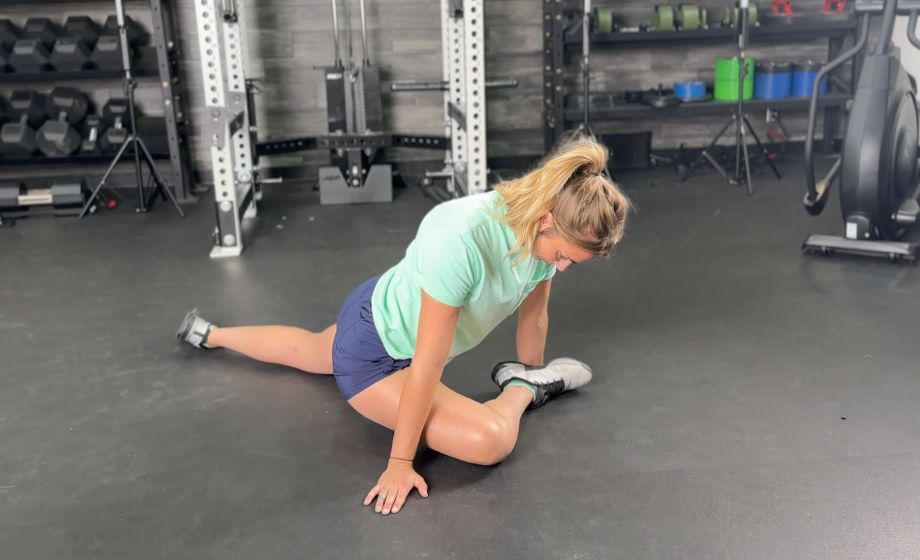
In addition to traditional saunas with heated rocks, one small study7 found that infrared sauna bathing more deeply penetrates heat into the body (nearly four centimeters deep into fat tissue and neuromuscular systems under the skin).
The study also found that the infrared lights were more helpful for muscle recovery and reducing soreness after resistance training than traditional saunas.
RELATED: What is Resistance Training?
Benefits of Steam Room Sessions
Moist heat from a steam room session is also shown to improve muscle recovery8, increase blood circulation9, and improve cardiovascular health10. While there is more research supporting traditional dry heat, here are a few additional benefits to steam rooms:
May Help Clear Congestion
Humid environments are often used as an at-home remedy for relieving sinus pressure from the common cold, sinusitis, or allergies. One 2016 study11 found that steam inhalation can reduce headaches from sinus pressure and promote better breathing with loosened mucous membranes.
The same study notes that nasal irrigation is the most effective method for recurring sinus symptoms.
May Be More Effective in Reducing DOMs
In the sections above, I covered how Finnish saunas reduce free radicals, which can lead to better recovery. I also cited a study that found infrared saunas penetrated heat more deeply into the skin, muscle, and fat tissues.

That said, there is a study published by the Journal of Clinical Medicine Research8 that says both dry and moist heat are effective at combating delayed onset muscle soreness (DOMS) from exercise. This study suggests that moist heat penetrates even deeper into muscle and fat tissue, which can allow you to get the same result in less time.
Steam Room Vs Sauna Final Thoughts
While steam rooms and saunas have plenty of potential benefits, there is more research on sauna use overall. And with the fact that saunas are more common and less humid, our experts agree that saunas make more sense for an at-home hot therapy option.
Here is summary of what we know about heat therapy in general:
- May help increase blood circulation
- May aid in muscle recovery from workouts
- Has potential to help improve heart health and reduce blood pressure
Steam Room Vs Sauna: FAQs
Below are some frequently asked questions on steam rooms and saunas:
Which is better: a steam room or a sauna?
While both have benefits, traditional dry saunas are more accessible for at-home use and are generally more common in spas and gyms. Dry saunas also don’t pose as much threat of mold due to lower humidity levels.
Is a sauna or steam room better for weight loss?
Because the heat is much higher in traditional dry saunas, it can cause you to sweat more and lose more water weight during a sauna session.
Should you use a sauna or steam room everyday?
Many of the studies done on the health benefits of sauna sessions have people perform regular sauna use. However, much like stimulus from exercise—rest days are recommended.
References
- Jari A. Laukkanen, MD, PhD; Tanjaniina Laukkanen, MSc; and Setor K. Kunutsor, MD, PhD. Cardiovascular and Other Health Benefits of Sauna Bathing: A Review of the Evidence. Mayo Clinic Proceedings. August 2018.
- Cable NT. Unlocking the secrets of skin blood flow. J Physiol. 2006;572(Pt 3):613. doi:10.1113/jphysiol.2006.109207
- Laukkanen T, Khan H, Zaccardi F, Laukkanen JA. Association Between Sauna Bathing and Fatal Cardiovascular and All-Cause Mortality Events. JAMA Intern Med. 2015;175(4):542–548. doi:10.1001/jamainternmed.2014.8187
- Taggart P, Parkinson P, Carruthers M. Cardiac responses to thermal, physical, and emotional stress. Br Med J. 1972;3(5818):71-76. doi:10.1136/bmj.3.5818.71
- Ketelhut S, Ketelhut RG. The blood pressure and heart rate during sauna bath correspond to cardiac responses during submaximal dynamic exercise. Complement Ther Med. 2019;44:218-222. doi:10.1016/j.ctim.2019.05.002
- Sutkowy P, Woźniak A, Boraczyński T, Mila-Kierzenkowska C, Boraczyński M. The effect of a single Finnish sauna bath after aerobic exercise on the oxidative status in healthy men. Scand J Clin Lab Invest. 2014;74(2):89-94. doi:10.3109/00365513.2013.860616
- Mero A, Tornberg J, Mäntykoski M, Puurtinen R. Effects of far-infrared sauna bathing on recovery from strength and endurance training sessions in men. Springerplus. 2015;4:321. Published 2015 Jul 7. doi:10.1186/s40064-015-1093-5
- Petrofsky J, Berk L, Bains G, et al. Moist heat or dry heat for delayed onset muscle soreness. J Clin Med Res. 2013;5(6):416-425. doi:10.4021/jocmr1521w
- Lohman EB 3rd, Sackiriyas KS, Bains GS, et al. A comparison of whole body vibration and moist heat on lower extremity skin temperature and skin blood flow in healthy older individuals. Med Sci Monit. 2012;18(7):CR415-CR424. doi:10.12659/msm.88320
- M. Pandiaraja, A. Vanitha, K. Maheshkumar, V. Venugopal, S. Poonguzhali, L. Radhika, N. Manavalan. Effect of the steam bath on resting cardiovascular parameters in healthy volunteers. Advances in Integrative Medicine. Volume 8, Issue 3. 2021.
- P. Little, B. Stuart, M. Mullee, T. Thomas, S. Johnson, G. Leydon, D. Rabago, S. Richards-Hall, I. Williamson, G. Yao, J. Raftery, S. Zhu, M. Moore. Effectiveness of steam inhalation and nasal irrigation for chronic or recurrent sinus symptoms in primary care: a pragmatic randomized controlled trial. CMAJ September 20, 2016 188 (13) 940-949; DOI: https://doi.org/10.1503/cmaj.160362
Further reading

Are Ritual multivitamins right for you? The GGR nutrition experts cover everything you need to know in our Ritual vitamins review! Read more

Looking to optimize your supplement stack? A registered dietitian explains when to take BCAA and creatine for best results! Read more

Hot and cold therapies are all the rage right now. And, if you follow the health and wellness community online, you may notice your social media feeds are filled with folks talking about the ice bath benefits, influencers plunging into cold water, or building DIY backyard saunas. But is all the buzz around heat therapy worth investing in one of the best home saunas or steam rooms?There are benefits of elevating your body’s temperature and exposure to both dry and moist heat. » Read more about: Steam Room Vs Sauna: Is One Better Than The Other? » Read more

In this TrueForm Trainer review, we’ll give our thoughts on this budget-friendly manual treadmill and compare it to the TrueForm Runner. Read more

